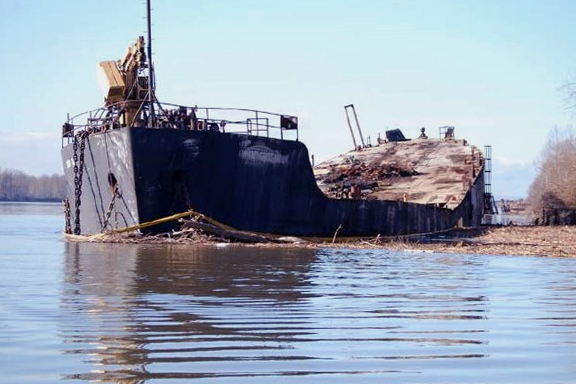Davy Crockett barge
Authorities respond to the illegal scrap metal salvage of the flat-deck Barge Davy Crockett on the Columbia River near Camas, Washington, on Jan. 27, 2011.
Summary information
North bank of the Columbia River near Camas, WA

View of the Davy Crockett barge in January 2011.
Status updates
Incident Background
The Washington Department Ecology received reports of oil sheen on the Columbia River near Vancouver, Wash., Jan. 27, 2011, and traced it 11 miles upstream to the 431-foot flat-deck barge Davy Crockett. Reports of sheen were reported as far as 14 miles downstream.
Last updated 11/23/2011
|
Incident duration |
295 days |
| Vessel removed (8/25/11) | 211 days |
| Cofferdam removed (11/17/11) | 295 days |
|
Injuries |
0 |
| Sediment Collected | 85.5 cubic yards |
|
Total Oil water mixture recovered to date |
1.6 million gallons* |
|
Total steel removed |
3.56 million pounds** |
|
Debris & oiled debris removed |
1.25 million pounds |
|
Bunker oil recovered |
38,397 gallons |
|
Asbestos removed |
4,850 pounds |
|
Samples analyzed to date (e.g. water, oil sediment) |
227 |
|
Obligated costs to date |
$22 million |
| **This is the weight of the steel after it was cleaned and recycled. Prior figures reported were for uncleaned steel, which reflected a heavier total. *This figure represents the amount of oily water mixture that has been recovered directly from the barge Davy Crockett during response operations. An initial unrecovered release of an estimated 70 gallons of oil was documented on January 27, 2011 the day the vessel was discovered to be leaking oil. |
|
Environmental Protection
All activities involving the destruction and removal of the Davy Crockett were designed to minimize environmental impacts. The impermeable oil and silt barrier inside the metal cofferdam along with sorbent oil collection booms prevented tar balls and oil sheen from discharging into the Columbia River downstream of the work site. Oil containment boom was deployed outside the cofferdam as a preventative measure in case there is a release of oil from the work site. Additional on-water oil recovery resources and oil containment boom were staged nearby as further protection.
Oil, oily water and contaminated water from the vessel’s holds and tanks were collected throughout the cleanup effort and taken off-site for proper disposal. In addition, wash water from cleaning operations and stormwater collected on the Davy Crockett and work barges was put through an on-site water filtration system and then disposed of through the city of Portland’s wastewater treatment system.
Water quality samples upstream, downstream and inside the cofferdam were being collected on a periodic basis in order to evaluate the effectiveness of work activities to minimize water pollution.
Sediment samples around the Davy Crockett and inside the cofferdam were also collected periodically during the project. After the vessel was removed from the river, deconstruction debris, contaminated sediments, metal slag and scale (metal “flakes”) were removed by divers using hand-operated dredging equipment. A final set of sediment samples were collected at the conclusion of the 38-day dredging operation.
News releases
- Dept. of Justice News Release - March 19, 2013
- Joint Media Packet - May 6, 2011
- USCG Press Release - March 30, 2011
- USCG Press Release - March 28, 2011
- USCG Press Release - March 11, 2011
- USCG Press Release - March 10, 2011
- USCG Press Release - February 16, 2011
- Joint Press Release - February 3, 2011
- Joint Press Release - February 1, 2011
- Joint Press Release - January 31, 2011
- Joint Press Release - January 30, 2011

